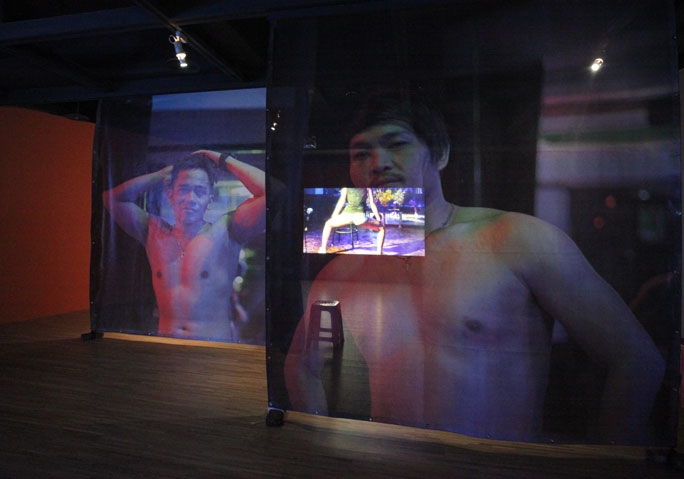Hong-Gah Museum, Taipei, 29 July – 17 September
Orange seems to be the colour when it comes to the representation of exoticism and desire. Taiwanese artist Yu Cheng-Ta’s solo exhibition Tell Me What You Want is covered in it: the banner, the brochure (with the Chinese and the English version in two different shades of orange), the partition walls, as well as the plastic stool-chairs that are typical of everyday life in Southeast Asia scattered in the exhibition space. And if you walk into the show at the right moment, when all the screens are synced to the very beginning, you will find yourself suddenly immersed in this shamelessly blunt colour, which does not, however, indicate any honesty in the narrative that’s about to unfold. The four videos, titled Malate, David, Joara and The Shop (all 2017), adopt the form of the mockumentary, offering a fictional framework for the exhibition that I think also echoes the ambiguous nature of the relationship between the artist and the subject of his research: the marketing boys in Manila. It is around this relationship that the whole project revolves.
Their services include taking you to all the clubs in the city’s red-light district, promising that you will have a great time
‘Marketing’ is a profession on the street of Malate, Manila. Guys sit on their motorcycles, waiting for the next customer – most of them are foreigners – to show up. ‘Tell me what you want,’ they say. Their services include taking you to all the clubs in the city’s red-light district, promising that you will have a great time, and of course you have to pay for their services. In the past two years or so, Yu frequently visited Manila, as a traveller and a film producer. He made friends with these local ‘marketings’. They knew him as ‘David’. But as you can see in the videos’ narrative, David then became a sort of alter ego of the artist in the sense that he’s always referred to in the third person – as if David had already fled the scene when the artist and his crew came to Malate and conducted the documentary-style interviews. “How did you know David?” they are asked, turning their encounter with him into something close to an investigation.
Will David (the artist) continue to help Junio in real life now his film project is done?
Four screens are placed in a semi-open space where you can hear all the soundtracks at the same time. It’s a little disturbing, but it helps recreate an acoustic field of the real Malate nightlife, a sensual experience crucial for the show. The structure that brings the four independent videos onto the same page reminds me of the composition of a novel: Malate sets up the stage, giving a sketch of the background city and luring you into the fictional world; David introduces the alleged protagonist, who’s the intersection point of all the storylines, while he himself enjoys a mysterious Great Gatsby kind of role; Joara (the name of a club they visited) is a closeup of Malate’s nightlife, where you can see faces, relationships and exchanges of desire rather intimately. The final chapter, The Shop, is different from the other three. For starters, it is installed in a separate and more private space, where you can sit and watch the whole thing without getting too distracted. Secondly, there’s more daylight in this piece, both literally and metaphorically, because it takes you away from the nightlife and leads you into the real life of one of the main characters, Junio. Junio wanted to have his own shop because he thought he had to consider his future after retirement from the marketing business. Junio turns to David for financial assistance, with the amount of money he demands increasing due to various reasons. Will David (the artist) continue to help Junio in real life now his film project is done? You wonder.
Yu makes it quite clear that he’s interested in the concepts of exchange that are fundamental elements of both the marketing business and this film project. He doesn’t try to sweep this intention under the rug, instead acknowledging and exposing the twisted desire to look into other people’s sometimes miserable lives. Furthermore, by asking two of the marketing boys to pose for his photography (two largescale portraits hang in the exhibition space as a dividing curtain; they posed for him for free because “David is a friend”) and promising the owner of Joara that he would produce a commercial for him in exchange for shooting in the club, Yu further complicates an already complicated network of transactions, pointing to the mechanism behind all kinds of human relations, artistic production included, and showing that you cannot neatly draw a line between friendship and pure exchange of interests, and consequently between the real and otherwise.
From the Winter 2017 issue of ArtReview Asia
